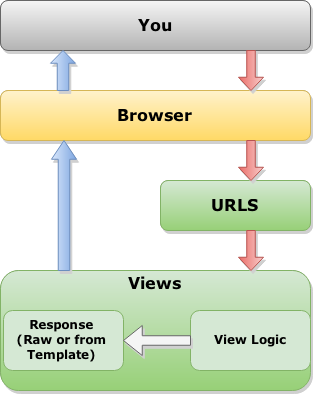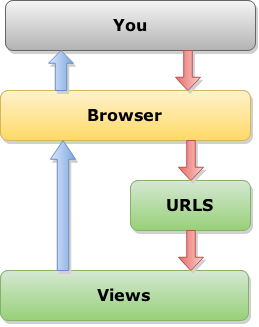We've see how the request/response cycle works in Django, but so far all we
are able to do is return some text via an HttpResponse. Your server currently
looks like this:
- A request comes in, and we try to match it to one of the patterns in
urls.py. - We find the matching view for that pattern in
views.pyand respond with some text.
We want a way to respond with files instead of text. We can do
this using templates, turning our server into this:

You can think of a template like a Mad-libs page. You have a series of blanks in your file that can be filled in later before giving the file back to the browser.
Let's try an example - first we have to add some settings. In buildup/settings.py,
add the following lines so Django knows where to look for templates.
BASE_DIR = os.path.dirname(os.path.dirname(__file__))
TEMPLATE_DIRS = (
os.path.join(BASE_DIR, "buildup/templates"),
)And now create the folder buildup/templates so we can add files to it. In the
terminal, navigate to your project folder and create the folder using mkdir
cd ~/GitHub/projects/django-buildup/buildup
mkdir templates
cd ..
Now let's create the file buildup/templates/hello.html
<html>
<head>
<title>A templated page: {{ yourname }}</title>
</head>
<body>
<marquee>Hey hi your name is {{ yourname }}!</marquee>
The value of foobar is {{ foobar }}
</body>
</html>Everything between the {{ and }} is a "blank" part of the template and
will be filled in later.
In urls.py, add a pattern for /hello_template/<YOURNAME>:
url(r'^hello_template/(?P<yourname>\w+)/$', 'buildup.views.hello_template', name='hello_template')In views.py, we're going to be using the render function, so add a line at
the top to import it:
from django.shortcuts import renderNow add your hello_template function below. Remember that it also takes
yourname as an argument because the url captured that for us!
def hello_template(request, yourname):
return render(request, "hello.html", { "yourname": yourname, "foobar": 12 })The render function takes the request, the name of a template to use, and
an optional "dictionary" to use for the context. A "dictionary" is a collection
of names (or keys) and values. In this case, the dictionary has the key "yourname"
whose value is what you provided in the url, and a key "foobar" whose value is 12.
The render function will use the hello.html template and replace "yourname"
and "foobar" in the template with the values you provided.
If everything went well, you should see an HTML page when you visit http://127.0.0.1:8000/hello_template/myname/!
Modify your time, random, and say views to use templates - you'll want to create
a template file for each one in buildup/templates and modify the buildup/views.py
to use render instead of HttpResponse.
